当前位置:
X-MOL 学术
›
J. Anim. Ecol.
›
论文详情
Our official English website, www.x-mol.net, welcomes your feedback! (Note: you will need to create a separate account there.)
How do insects choose flowers? A review of multi‐attribute flower choice and decoy effects in flower‐visiting insects.
Journal of Animal Ecology ( IF 4.8 ) Pub Date : 2020-10-12 , DOI: 10.1111/1365-2656.13347 Tanya Latty 1 , Jennifer S Trueblood 2
Journal of Animal Ecology ( IF 4.8 ) Pub Date : 2020-10-12 , DOI: 10.1111/1365-2656.13347 Tanya Latty 1 , Jennifer S Trueblood 2
Affiliation

|
Understanding why animals (including humans) choose one thing over another is one of the key questions underlying the fields of behavioural ecology, behavioural economics and psychology. Most traditional studies of food choice in animals focus on simple, single attribute decision tasks. However, animals in the wild are often faced with multi-attribute choice tasks where options in the choice set vary across multiple dimensions. Multi-attribute decision making is particularly relevant for flower-visiting insects faced with deciding between flowers that may differ in reward attributes such as sugar concentration, nectar volume, and pollen composition as well as non-rewarding attributes such as colour, symmetry and odour. How do flower-visiting insects deal with complex multi-attribute decision tasks? Here we review and synthesise research on the decision strategies used by flower visiting insects when making multi-attribute decisions. In particular, we review how different types of foraging frameworks (classic optimal foraging theory, nutritional ecology, heuristics) conceptualise multi-attribute choice and we discuss how phenomena such as innate preferences, flower constancy and context dependence influence our understanding of flower choice. We find that multi-attribute decision making is a complex process that can be influenced by innate preferences, flower constancy, the composition of the choice set and economic reward value. We argue that to understand and predict flower choice in flower-visiting insects, we need to move beyond simplified choice sets toward a view of multi-attribute choice which integrates the role of non-rewarding attributes and which includes flower constancy, innate preferences and context dependence. We further caution that behavioural experiments need to consider the possibility of context-dependence in the design and interpretation of preference experiments. We conclude with a discussion of outstanding questions for future research. We also present a conceptual framework that incorporates the multiple dimensions of choice behaviour.
中文翻译:

昆虫是如何选花的?访花昆虫的多属性花卉选择和诱饵效应综述。
理解为什么动物(包括人类)选择一件事而不是另一件事是行为生态学、行为经济学和心理学领域的关键问题之一。大多数关于动物食物选择的传统研究都集中在简单的、单一属性的决策任务上。然而,野外动物经常面临多属性选择任务,其中选择集中的选项在多个维度上有所不同。多属性决策尤其与访花昆虫相关,它们面临着在奖励属性(例如糖浓度、花蜜量和花粉成分)以及非奖励属性(例如颜色、对称性和气味)方面可能不同的花朵之间的决定。访花昆虫如何处理复杂的多属性决策任务?在这里,我们回顾和综合研究了花访问昆虫在进行多属性决策时所使用的决策策略。特别是,我们回顾了不同类型的觅食框架(经典最佳觅食理论、营养生态学、启发式)如何概念化多属性选择,并讨论先天偏好、花卉恒常性和上下文依赖等现象如何影响我们对花卉选择的理解。我们发现多属性决策是一个复杂的过程,会受到先天偏好、花卉恒常性、选择集的组成和经济奖励价值的影响。我们认为,为了理解和预测访花昆虫的花选择,我们需要超越简化的选择集,转向多属性选择的观点,该观点整合了非奖励属性的作用,包括花的恒常性、先天偏好和上下文依赖。我们进一步警告说,行为实验需要在偏好实验的设计和解释中考虑上下文依赖的可能性。我们最后讨论了未来研究的未决问题。我们还提出了一个包含选择行为的多个维度的概念框架。我们进一步警告说,行为实验需要在偏好实验的设计和解释中考虑上下文依赖的可能性。我们最后讨论了未来研究的未决问题。我们还提出了一个包含选择行为的多个维度的概念框架。我们进一步警告说,行为实验需要在偏好实验的设计和解释中考虑上下文依赖的可能性。我们最后讨论了未来研究的未决问题。我们还提出了一个包含选择行为的多个维度的概念框架。
更新日期:2020-10-12
中文翻译:

昆虫是如何选花的?访花昆虫的多属性花卉选择和诱饵效应综述。
理解为什么动物(包括人类)选择一件事而不是另一件事是行为生态学、行为经济学和心理学领域的关键问题之一。大多数关于动物食物选择的传统研究都集中在简单的、单一属性的决策任务上。然而,野外动物经常面临多属性选择任务,其中选择集中的选项在多个维度上有所不同。多属性决策尤其与访花昆虫相关,它们面临着在奖励属性(例如糖浓度、花蜜量和花粉成分)以及非奖励属性(例如颜色、对称性和气味)方面可能不同的花朵之间的决定。访花昆虫如何处理复杂的多属性决策任务?在这里,我们回顾和综合研究了花访问昆虫在进行多属性决策时所使用的决策策略。特别是,我们回顾了不同类型的觅食框架(经典最佳觅食理论、营养生态学、启发式)如何概念化多属性选择,并讨论先天偏好、花卉恒常性和上下文依赖等现象如何影响我们对花卉选择的理解。我们发现多属性决策是一个复杂的过程,会受到先天偏好、花卉恒常性、选择集的组成和经济奖励价值的影响。我们认为,为了理解和预测访花昆虫的花选择,我们需要超越简化的选择集,转向多属性选择的观点,该观点整合了非奖励属性的作用,包括花的恒常性、先天偏好和上下文依赖。我们进一步警告说,行为实验需要在偏好实验的设计和解释中考虑上下文依赖的可能性。我们最后讨论了未来研究的未决问题。我们还提出了一个包含选择行为的多个维度的概念框架。我们进一步警告说,行为实验需要在偏好实验的设计和解释中考虑上下文依赖的可能性。我们最后讨论了未来研究的未决问题。我们还提出了一个包含选择行为的多个维度的概念框架。我们进一步警告说,行为实验需要在偏好实验的设计和解释中考虑上下文依赖的可能性。我们最后讨论了未来研究的未决问题。我们还提出了一个包含选择行为的多个维度的概念框架。

























 京公网安备 11010802027423号
京公网安备 11010802027423号